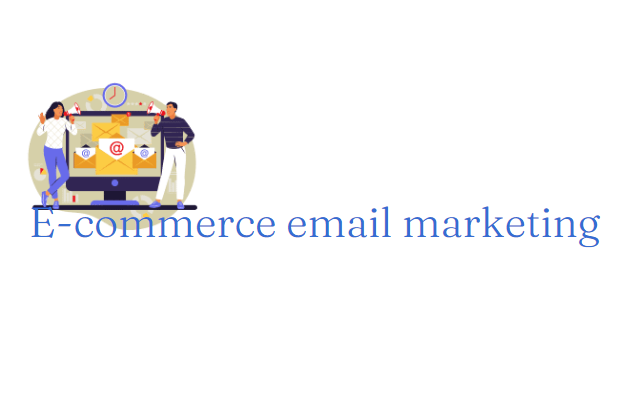10 Ecommerce Email Marketing Tips to Use in 2023
- What is email marketing for eCommerce?
- Benefits of marketing messages
- How to do email marketing
- 10 best email marketing campaigns
- Types of marketing emails
- Templates for marketing emails
- Tracking performance
- Email marketing for a successful eCommerce store
- Strategy for eCommerce businesses
- Conclusion
Unlock the full potential of your online store with the power of eCommerce email marketing. In today’s competitive business world, building a strong bond with your customers is essential for succeeding in eCommerce.
Fortunately, email marketing offers a direct and highly effective channel to engage, convert, and nurture your audience. By leveraging the insights and strategies shared by industry experts, you can take your eCommerce email marketing game to new heights.
Get ready to supercharge your campaigns and start a journey to maximize your online store’s growth and revenue.
Let’s dive into the world of eCommerce email marketing and unleash the true potential of your business.
What is email marketing for eCommerce?
eCommerce email marketing is the practice of using email to send targeted marketing messages to current and potential customers.
It can be as simple as sending regular newsletters or as complex as automated email series for cart abandonment, customer re-engagement, and exclusive deals. The goal is to increase customer engagement and drive conversions.
Benefit from email marketing as an eCommerce business
Firstly, eCommerce email marketing provides a direct and personalized communication channel with customers. It allows businesses to reach their audience directly in their inboxes, delivering personalized messages that resonate with individual customers.
Secondly, email marketing enables businesses to target their messaging effectively. By segmenting their audience based on various criteria such as purchase history or demographics, businesses can deliver relevant content and offers to specific customer segments.
What is more, eCommerce email marketing is an effective tool for driving customer engagement.
By delivering valuable content, promotions, and updates via email, businesses can keep their brand top of mind and encourage customers to interact with their products or services. This can lead to increased website traffic, social media engagement, and repeat customers.
Since ecommerce email marketing campaigns help optimize conversions businesses can strategically place compelling calls to action within their emails. For instance, exclusive offers or personalized recommendations will entice customers to take action.
Not to mention, email marketing is a cost-effective marketing strategy. Compared to traditional advertising channels, email campaigns typically require lower investments while still reaching a large audience.
Finally, it provides valuable data and insights.
Businesses can gain insights into customer behavior and campaign performance by analyzing metrics such as open rates, click-through rates, and conversions. These data-driven insights help refine marketing strategies, improve targeting, and enhance overall effectiveness.
6 key factors of email marketing
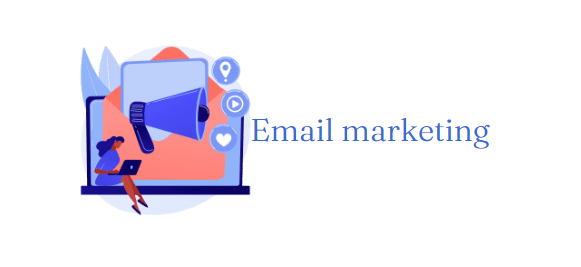
If you’re new to eCommerce email marketing, here are some simple steps to get started with your eCommerce business:
- Set realistic goals: Determine what you want to achieve with email marketing, such as growing your email list or increasing customer retention by a certain percentage.
- Choose an email marketing software: Pick a tool like MailChimp or Constant Contact to help you manage and send your email campaigns.
- Plan your campaigns: Outline the types of emails you want to send, such as welcome emails for new subscribers, follow-ups for abandoned carts, or emails for promoting new products.
- Collect email addresses: Decide how you’ll gather email addresses from your customers. One popular method is offering a small coupon or discount in exchange for their email.
- Create landing pages: If needed, set up dedicated web landing pages where customers can sign up for your emails or take specific actions related to your campaigns.
- Track your campaigns: Use an analytics provider to monitor the performance of your email campaigns. This will help you understand what’s working and make improvements.
10 email marketing campaigns to utilize
Whether you’re a beginner or looking to improve your existing email marketing, our top eCommerce email marketing strategies will give you a strong foundation to build your successful email marketing campaigns.
1.) Welcome email
To make a great impression on new subscribers, it’s important to create a welcome email series. This series allows you to introduce your eCommerce brand, showcase your best products, and even offer a discount to encourage sales.
A welcome series is effective in driving engagement because it typically consists of two or three emails. Sending more than that may come across as spammy and turn off email subscribers.
With two emails, you can warmly welcome the customer and invite them to connect further. With three emails, you have the opportunity to do the previous steps and also get to know the customer on a more personal level.
For example, look at the welcome email of Cider, they welcome the customer and offer a 15% discount on the first purchase.

Whether you choose two or three emails, it’s important to include certain key elements in each one.
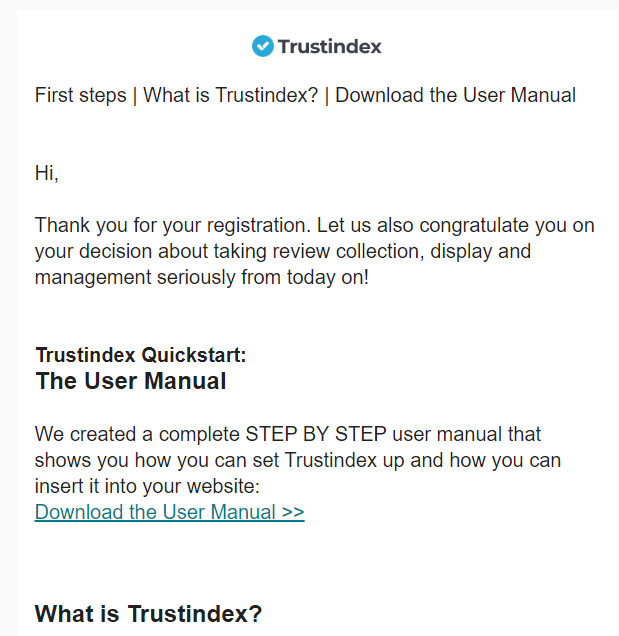
The initial welcome email should:
- Thank the subscriber for joining.
- Welcome them to your brand.
- Let them know what to expect in future emails.
- If you promised a discount or any special offer upon sign-up, be sure to include it in this email.
The second welcome email should:
- Provide additional ways for email subscribers to connect, such as through mobile apps or social media.
- Highlight the value that you or your products can bring to their lives.
- Explain why they should consider making a purchase.
By implementing a well-crafted welcome series, you can make a positive impression on subscribers and set the stage for successful personalized email campaigns.
2.) Call to action
What action do you want your subscribers to take?
It’s important to clearly communicate your desired outcome, whether it’s reading a blog post, watching a video, or purchasing a product.
A call to action (CTA) is a prompt that guides users to take a specific action. It can be a button or hyperlink in a newsletter, on a website, or in a video. Including a clear CTA in your emails can significantly boost clicks and sales.
When creating compelling CTAs for your email marketing campaigns, remember these tips:
- Define your end goal: Understand what specific action you want your subscribers to take.
- Use action-oriented words: Choose strong verbs that prompt immediate action.
- Address your audience in the first person: Personalize the CTA by using “I” or “my” to create a sense of ownership.
- Keep it concise: Keep your messaging short and to the point, making it easy for subscribers to understand.
- Be conversational: Adopt a friendly and approachable tone to connect with your audience.
Regularly A/B test your CTAs to find the most effective variations. Test different elements such as verbs, button shape, color, length, and word order.
For example, Unbounce experienced a 90 percent increase in click-through rates by changing “Start your free 30-day trial” to “Start my free 30-day trial.”
By applying these strategies, you can create compelling CTAs that drive engagement and encourage your repeat customers to take the desired actions.
3.) Make an impression through personalized emails
When was the last time you received an email that felt specifically made just for you? Chances are, that personalized email had a greater impact on you and motivated you to take action.
In fact, personalized promotional emails have been found to increase transaction rates and revenue by six times compared to non-personalized emails.
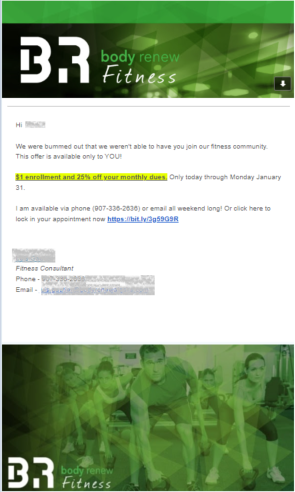
Personalized marketing can be categorized into three main types: contextual, demographic, and behavioral.
- Contextual personalization takes into account where a customer is in their journey. It considers whether they are just starting to explore a topic or if they are ready to make a purchasing decision.
- Demographic personalization uses information such as age, gender, location, and household income level to provide recommendations and tailor the content to specific groups.
- Behavioral personalization takes into consideration a customer’s past purchases or website behavior, such as abandoned carts. For example, Etsy may send an email showcasing products based on a customer’s previous purchases.
Depending on the size of your email list, you can even combine these personalization categories to create intersections. For instance, you could combine past purchase history with location-based recommendations for new products or offers.
As you segment your email list more precisely, your marketing campaigns become more personalized. This increased personalization is likely to result in more successful and impactful campaigns.
4.) Automated email campaigns
Did you know that according to Campaign Monitor, automated emails generate 320 percent more revenue compared to non-automated emails?
This makes automated email campaigns a valuable asset in your overall marketing strategy.
Automated emails can take your eCommerce email marketing to the next level. They encompass a range of campaigns, including welcome series, cart abandonment reminders, transactional emails, and re-engagement campaigns.
To leverage the power of automated emails, it’s important to choose reliable email marketing software.
Leading platforms like Klaviyo offer valuable resources to help you automate your emails effectively. They provide blog posts on automation flows to consider and offer user guides to help you set up your automated email sequences successfully.
5.) Abandoned cart series
A cart abandonment series can be incredibly profitable for your eCommerce business.
With an average open rate of 41.18 percent and a click rate of 9.50 percent, abandonment emails present a significant opportunity for conversion.
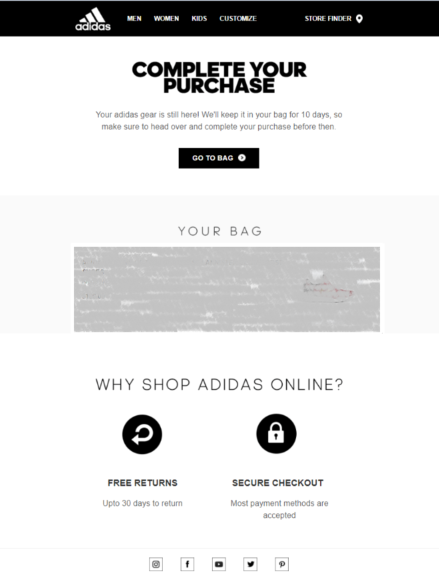
When creating a cart abandonment series, consider the following factors:
- Number of emails: Typically, a series of three or four emails works best to effectively re-engage potential customers who have abandoned their carts.
- Frequency and intervals: Experiment with sending the first email about an hour after the cart abandonment, followed by another email the next day, and the final one three days later. This helps to remind and prompt customers to complete their purchase.
- Discounts: Offering a discount code specifically on the products left in the cart can be a powerful incentive to secure a sale.
- Subject lines: Craft compelling subject lines that grab attention and encourage recipients to open the email. The subject line plays a crucial role in influencing the click-through rate of your cart abandonment series.
- Calls to action (CTAs): Your CTAs should be persuasive and compelling, urging prospective customers to return to their abandoned carts and complete the purchase.
Moreover, your cart abandonment series provides an excellent opportunity for personalization. Tailor the content and recommendations based on the customer’s browsing and cart history to create a more personalized and relevant experience.
6.) Effective split testing
Do you want to ensure that your email campaigns are as effective as possible? Enter split testing!
Split testing, or A/B testing, is a marketing strategy that involves comparing multiple variations of an element to determine which one performs better.
For instance, you can test two different CTA buttons—one black with white text and the other white with black text—to see which one drives higher engagement.
The purpose of split testing is to discover the best variations of common email elements, ultimately maximizing your return on investment. In fact, it can lead to significant improvements in conversion rates, sometimes even up to 400 percent.
Here are some elements you can test in your eCommerce email campaigns:
- Subject lines
- Preview text
- Product imagery
- Layout
- Image size
- Font size
- Font color
- Button color
- Send day and time
- Copy (text content)
- Pricing and discounts
- Social media icons
To conduct successful split tests, remember these ground rules:
- Test one variable at a time: Focus on changing one element per test to accurately measure its impact.
- Identify your goal: Determine what you want to achieve with the test, whether it’s higher open rates, click-through rates, or conversions.
- Establish a control and a challenger: Designate one variation as the control (current version) and the other as the challenger (new version) for comparison.
- Split groups equally and randomly: Divide your audience into two equal groups, randomly assigning each group to either the control or challenger.
- Decide significance parameters: Determine the level of statistical significance you require to determine if the results are valid and conclusive.
Once you have obtained statistically significant results, it’s time to implement any necessary changes based on your findings. By continuously split testing and optimizing your email marketing campaigns, you can enhance their effectiveness and achieve better results.
7.) Boost Engagement
Engagement emails shouldn’t be limited to just welcome campaigns; they can be utilized in email newsletters as well.
If you notice high open rates but lack click-through rates, it’s time to leverage engagement-focused emails.
Segment your audience based on their engagement levels and deliver targeted messages accordingly.
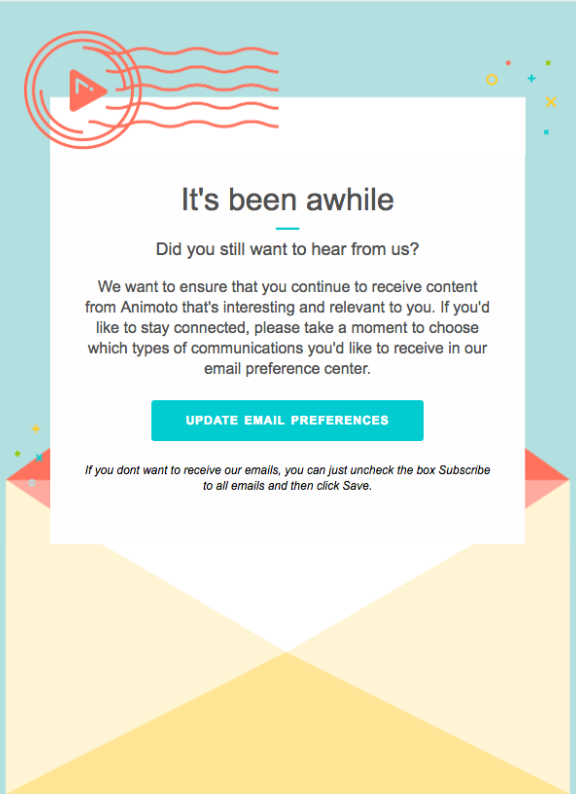
Subscribers who have previously converted are significantly more likely (74.7 percent) to do so again. This presents an opportunity to capitalize on the trust they have in your brand.
Put yourself in the shoes of the customer and think through why would they be loyal to your business. Use this insight to craft a product recommendations email tailored to their previous purchase.
For consumable products, consider offering a subscription offer email. If it’s a non-consumable product, a complementary product email can be a safe and relevant choice.
For subscribers who have yet to convert, your focus should be on building brand trust and reducing the perceived risk of making a purchase.
Offer discounts or special promotions to make the decision to buy from you less risky and more enticing.
By delivering engaging and personalized content to your subscribers, you can nurture their trust, drive repeat purchases, and encourage new customers to take the plunge and make their first purchase.
8.) Reward your loyal customers
Segmentation plays a crucial role in personalizing emails and rewarding loyal customers.
By dividing your email list based on factors like longtime subscribers or high-spending customers, you can create an exclusive experience that makes them feel appreciated and valued by your brand.
It’s important to focus on providing an experiential reward rather than solely relying on discounts.
While discounts can be seen as rewards, they also have the potential to diminish your brand’s value, especially in the eyes of loyal customers who already understand the worth of your products.
Consider offering experiential rewards that align with millennial spending habits. Studies show that 78 percent of millennials prefer spending their money on experiences rather than just products.
Some ideas include:
- Offering once-in-a-lifetime trips as rewards.
- Arranging meet and greet events with brand ambassadors.
- Creating an exceptional rewards program.
- Establishing a top-tier social media group where you host virtual events and provide exclusive content.
These experiential rewards not only make your loyal customers feel special but also help foster a deeper connection with your brand.
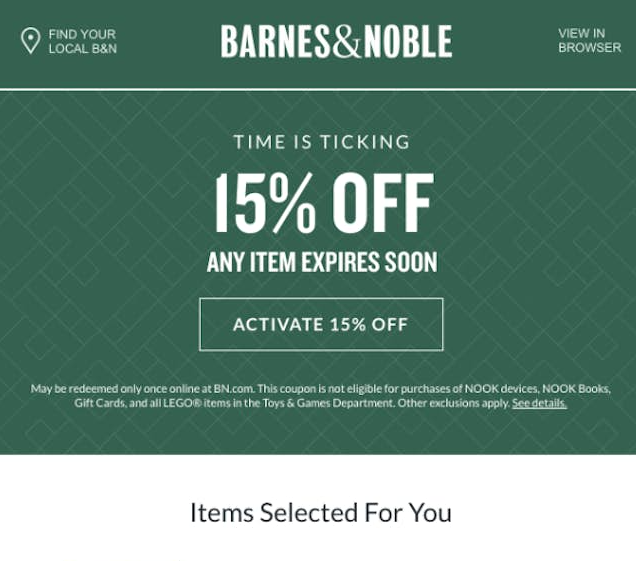
By going beyond discounts and offering unique experiences, you can enhance customer loyalty and encourage them to become enthusiastic advocates for your business.
9.) Wishlist and back-in-stock emails
Another valuable automated email campaign to add to your arsenal is the back-in-stock or “wishlist” emails.
With supply chain constraints becoming more common, many brands face challenges in stocking and maintaining inventory for certain items.
Instead of simply removing temporarily unavailable products from your website, you can leverage customer desires and maximize opportunities with back-in-stock emails.
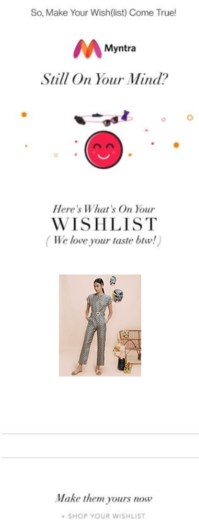
As the name suggests, back-in-stock emails notify customers when a product they showed interest in is now available for purchase again.
Depending on your platform, this feature may be available as a built-in option on the product page, or it may require additional configuration and the use of add-ons or apps.
While implementing back-in-stock emails may require some effort on your part, the return on investment is worth it.
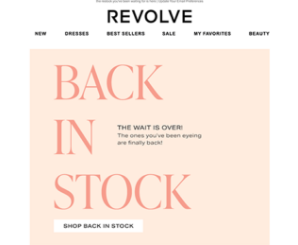
A study by Barilliance found that back-in-stock emails achieved the highest open rate (65.32 percent) compared to other types of post-purchase emails.
This indicates a high level of customer engagement and interest when they receive notifications about the availability of desired products.
It’s an effective way to capitalize on customer desires and generate more conversions for your eCommerce business.
10.) Leverage dynamic content
Personalization has already proven to be a powerful driver of conversions.
However, there’s a subset of personalization called dynamic content that takes it to the next level, with studies showing that it can increase email return on investment (ROI) by a staggering 100 percent!
But what exactly is dynamic content?
Dynamic content refers to personalized content that is generated based on user signals and behaviors. It takes into account various factors to deliver highly relevant and tailored content to individual recipients.
Here are a few examples:
- Product recommendations: Based on a customer’s past purchases or previously viewed products, dynamic content can showcase personalized product recommendations that align with their preferences and interests.
- Customized calls to action (CTAs): By analyzing the user’s browsing behaviors and interactions with your website, dynamic content can deliver CTAs that are specifically tailored to their interests, guiding them towards the next steps in their buyer’s journey.
- Exclusive offers for different stages: Dynamic content can provide free exclusive offers, such as ebooks or white papers, to customers who are in the “research” stage of their buyer’s journey.
- This helps to nurture their interest and provides valuable resources that support their decision-making process.
Most major email marketing software companies offer the capability to include dynamic content in your eCommerce email templates.
Types of eCommerce email marketing
#Transactional emails
Transactional emails are functional emails sent during checkout and other purchasing actions. They have high open rates (around 60%) because customers actively seek them out for important information.
Optimizing transactional emails enhances the customer experience, builds trust, and encourages repeat business.
1.) Email receipts and order confirmations
Optimizing order confirmation and email receipt emails can enhance the customer experience and drive repeat business.
Here are some ways to improve these emails:
- Upsell and offer add-ons: Suggest related products or offer the option to add accessories or gifts to the purchase before it ships.
- Provide bounce-back offers: Offer a discount code or free shipping for a future purchase within a limited time frame to encourage customers to return.
- Encourage community engagement: Invite customers to join your community or participate in events to foster a sense of belonging.
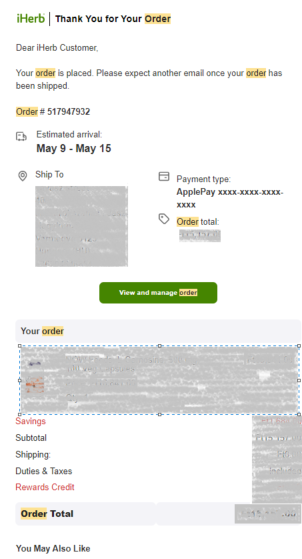
2.) Shipping Confirmation Email
Shipping confirmation emails provide an opportunity to engage customers and deepen their relationship with your brand.
Consider the following strategies:
- Easy tracking: Include the expected delivery date and a tracking number linked to the shipping company for seamless order tracking.
- Referral program promotion: Encourage customers to refer friends and family by offering incentives or discounts.
- Personalized product suggestions: Recommend complementary products based on the customer’s purchase to increase cross-selling opportunities.
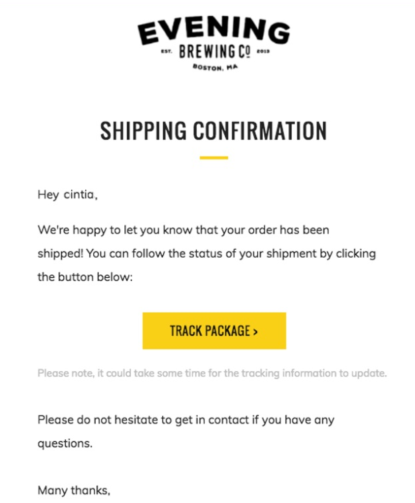
3.) Check-in Email
Gathering customer feedback is crucial for improving your business.
Utilize check-in emails to collect customer insights and enhance the shopping experience:
- Customer satisfaction focus: Prioritize customer feedback to understand their satisfaction level and identify areas for improvement.
- Convenient feedback process: Include a survey or rating system in the email or direct customers to a third-party survey tool on your website.
- Follow-up with unhappy customers: Reach out to dissatisfied customers to address their concerns and find ways to enhance future experiences.
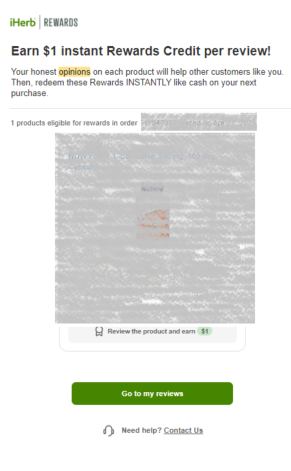
4.) Thank You Email
Thank you emails are effective for fostering customer loyalty and driving engagement.
Consider the following tactics for optimizing thank you emails:
- Keep it simple: Keep the message concise and include a clear call to action for customers to continue interacting with your business.
- Use smart CTAs: Personalize the email by using smart CTAs that adapt to the recipient, increasing the likelihood of follow-through.
- Social media integration: Make the email shareable on social media platforms to expand your reach and encourage customers to spread the word.
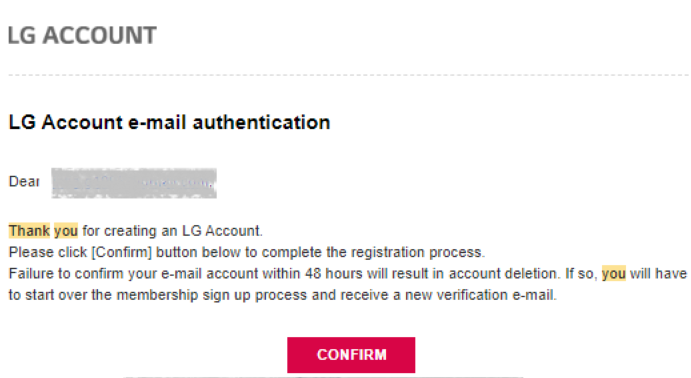
#Promotional emails
Promotional emails are a valuable tool to raise awareness and drive engagement. Here are different types of promotional emails and how to optimize them:
1.) Broadcast emails
- Introduce new products or services to your subscribers, targeting specific segments based on their preferences or previous purchases.
- Create time-sensitive deals that align with customers’ interests, offering discounts on items similar to their recent purchases.
- Provide subscriber-only discounts to create a sense of exclusivity and encourage purchases.
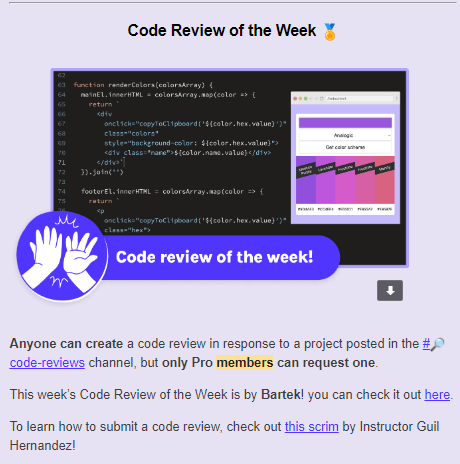
2.) Seasonal Promotions
- Notify subscribers about special offers related to upcoming holidays or specific times of the year, such as Black Friday or spring clearance sales.
- Remind customers of important occasions like Father’s Day and promote relevant products or deals.
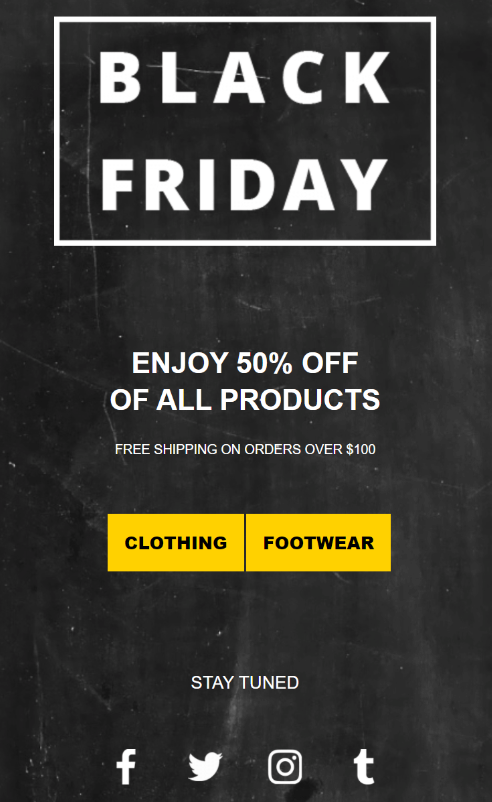
3.) Newsletter
- Use regular email newsletters to educate customers, share your brand story, and build stronger connections without relying solely on discounts or promotions.
- Incorporate compelling stories from staff members, customers, or your own business to engage readers and highlight your brand’s values.

4.) Content Update
- Include content marketing pieces in your newsletters or set up automated emails with new content delivered via RSS feeds.
- Provide additional context for new or updated products, such as grooming tips for beauty products, to enhance the customer experience.
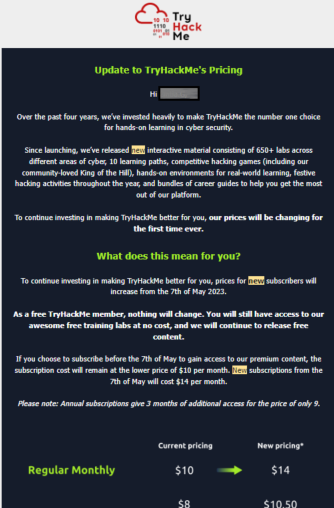
5.) Upsell and Cross-Sell Emails
- Use upsell emails to inform customers about premium or upgraded versions of items they have added to their cart, increasing the average order value.
- Send cross-sell emails based on customers’ previous actions, recommending complementary products or brands of interest.
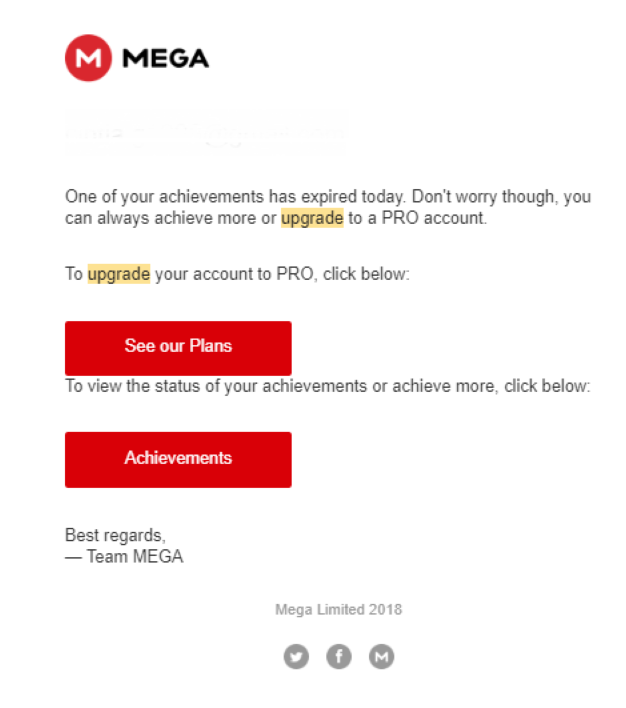
#Lifecycle emails
Lifecycle emails, also known as triggered emails, are highly personalized and target specific segments of your subscribers based on their behavior and position in the customer lifecycle.
Here are some key types of lifecycle emails and tips to optimize them:
1.) Shopping Cart Abandonment Emails
- Capitalize on the high shopping cart abandonment rate by sending emails to win back potential customers.
- Include incentives like discounts or free shipping to motivate customers to complete their purchase.
- Use text-based messages with a clear call to action and visuals of the abandoned products to remind customers of their intent.
2.) Welcome Email Series
- Create a series of emails to welcome new subscribers and make a strong first impression.
- Provide immediate value, such as a discount code or free shipping offer, to encourage engagement and future purchases.
- Set transparent expectations about the content and frequency of your emails and allow subscribers to manage their preferences easily.
3.) Second Order Emails
- Identify patterns in customer behavior and design automated email campaigns to promote complementary products or services.
- Offer discounts or highlight exclusive deals to entice customers to make a second purchase.
- Use customer data and segmentation to personalize the emails and increase their effectiveness.
4.) Win-Back Email Series
- Target inactive or lapsed customers with a series of emails to re-engage them and encourage repeat purchases.
- Offer incentives or exclusive discounts to incentivize their return.
- Test different offers and timing to find the most effective approach for your specific store and industry.

5.) Referral Email Campaigns
- Leverage the power of word-of-mouth by encouraging satisfied customers to refer their friends and family.
- Provide clear incentives for both the referrer and the referred customer, such as discounts or rewards.
- Craft compelling headlines and personalize the emails to increase engagement and participation.
6.) Survey Emails
- Gather valuable feedback from your customer base through survey emails to improve your business.
- Make the subject line eye-catching and indicate the time required to complete the survey.
- Offer incentives or rewards to encourage participation and increase response rates.
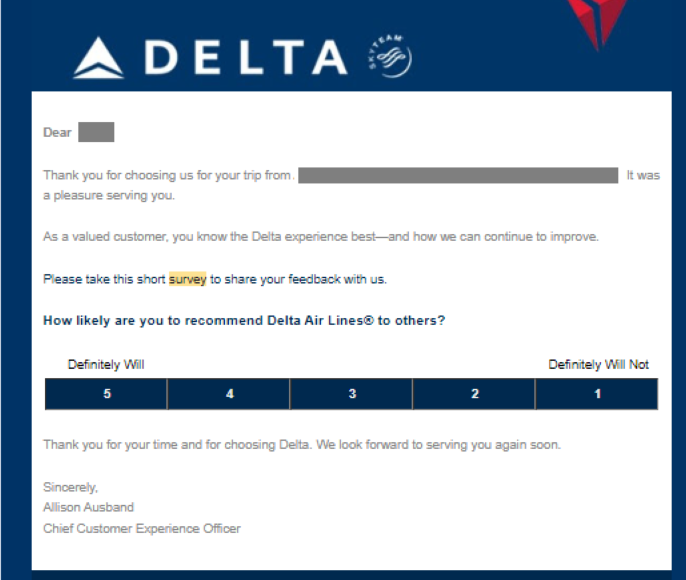
Email marketing tempelates
1.) Welcome email
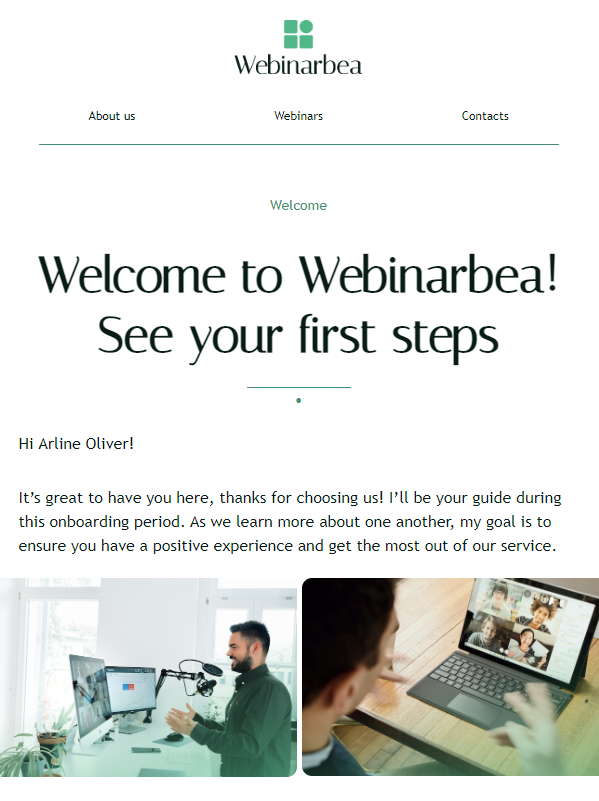
Introducing our captivating welcome email template that beautifully blends clean lines with vibrant pops of color, creating a visually stunning and attention-grabbing design.
When personalizing this template, don’t forget to leverage the prominent “featured image” area, where you can showcase a warm and inviting brand image or highlight a lifestyle shot featuring a product that resonates with your unique identity.
2.) Abandoned cart
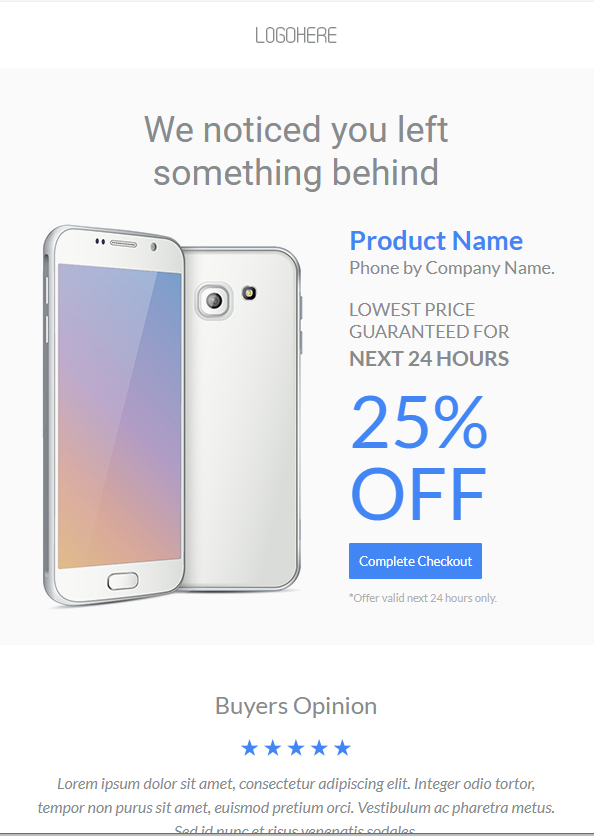
Discover the exceptional abandoned cart email template, meticulously crafted for eCommerce sites, boasting a creative and polished design.
With stylized text and a prominent product image, this template ensures effortless readability while captivating your audience with its clever and humorous copy.
3.) Discount emails
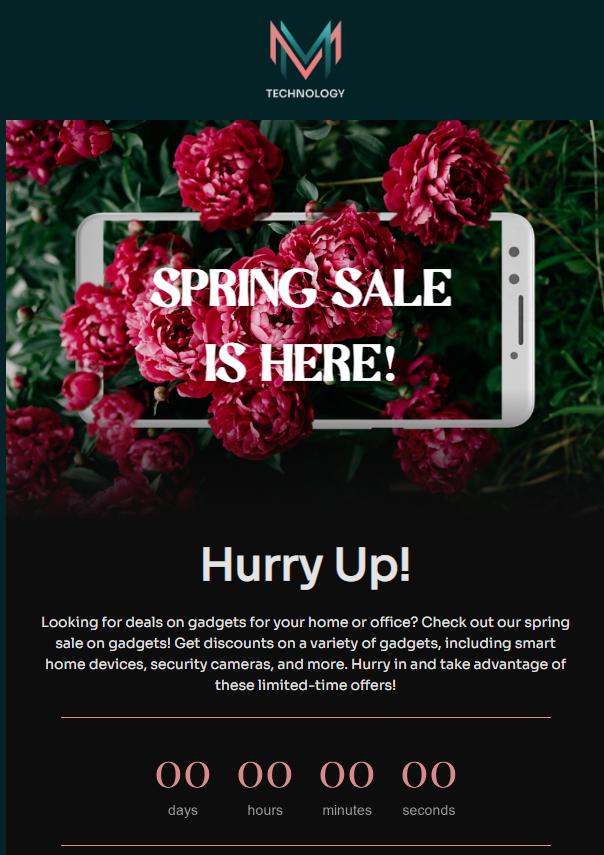
Unleash the power of this exquisitely stylized email template to announce your grand sales event.
With its captivating design, highlighted by striking text and dedicated modules for showcasing product imagery, this template ensures that your customers can easily perceive the immense value of your irresistible offer.
4.) Product recommendation
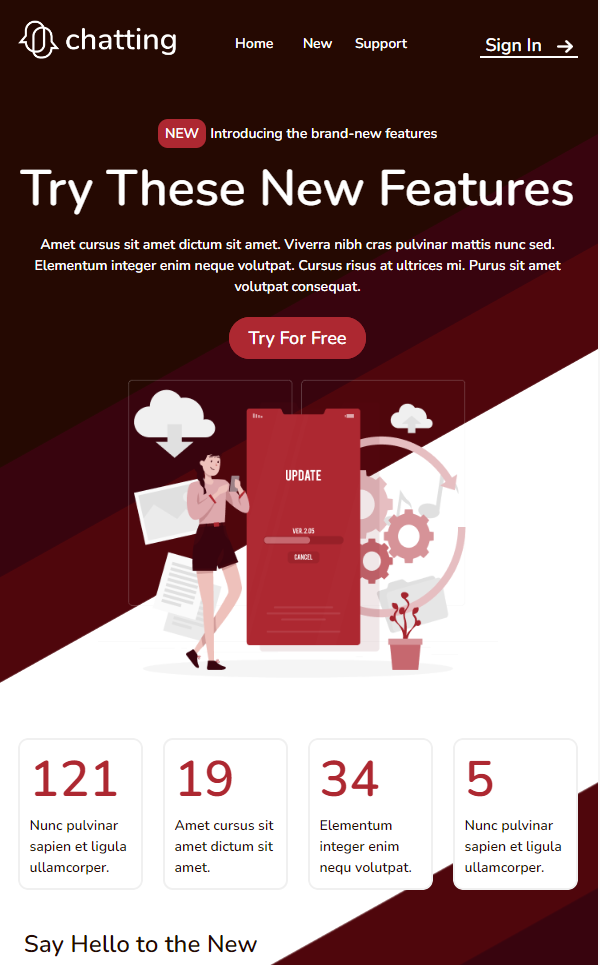
Allow your product recommendations to speak volumes through this visually captivating email template that puts images at the forefront.
With its image-heavy layout, your readers will be captivated by the stunning visuals, creating an immersive shopping experience that mimics browsing your website.
The inclusion of a faux navigation element adds a unique touch, making your readers feel like they are exploring your website while perusing the email.
5.) Check-in email
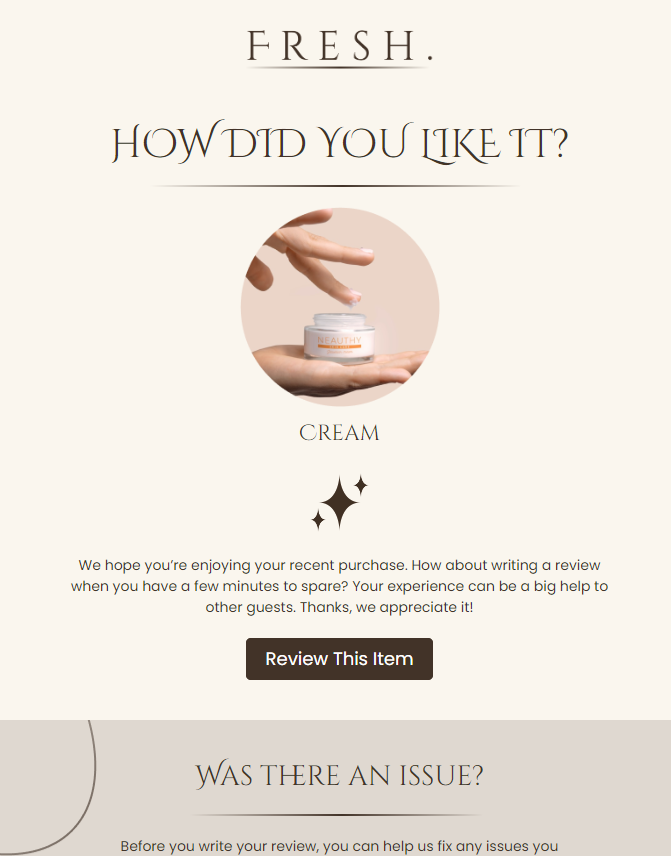
Designed with simplicity and efficiency in mind, this follow-up email template features a clean and streamlined design that is perfect for requesting post-purchase feedback from your valued customers.
Its minimalistic layout ensures that the focus remains on the feedback request, making it easy for recipients to provide their input without any distractions.
Whether you want to gather product reviews, ratings, or general feedback, this template provides an ideal platform to engage with your customers and gather valuable insights.
Tracking email marketing performance
1.) List size and growth
Monitoring the size and growth of your email list is essential for expanding your reach and driving sales.
Utilize your email service provider to track the number of new subscribers you’ve acquired on a weekly or monthly basis, as well as the growth between your recent email campaigns.
2.) Open and click-through rates
The open rate indicates the percentage of successfully delivered emails that were opened by subscribers. A typical open rate ranges from 20% to 33%. It’s common to observe higher open rates when you’re starting out.
The click-through rate represents the percentage of successfully delivered emails that received at least one click.
A standard click-through rate is generally two to three times higher than the conversion rate of your online store, averaging around 3% according to Mailchimp.
While open and click-through rates measure distinct behaviors, they provide insights into the engagement levels of your emails.
If there is a significant disparity—for example, many opens but few clicks on the call to action—you can identify areas for improvement.
3.) Deliverability and list health
A hard bounce occurs when an email is returned to the sender due to an invalid address. A good hard bounce rate is below 2%.
Spam filters evaluate various factors to determine email scores. If an email’s score exceeds a certain threshold, it may be flagged as spam by the email server.
To maintain deliverability and list health, it’s advisable to avoid:
- Using excessive capitalization, exclamation marks, or trigger words like “FREE”
- Incorporating large images with minimal text, as some spam filters may not recognize images
- Emailing outdated lists that haven’t been properly maintained over time
- Repeatedly receiving spam complaints, which can negatively impact your deliverability rates for all subscribers
Avoid purchasing email lists, sending emails without explicit permission, being unclear about the frequency of emails, hiding the unsubscribe option, making the unsubscribe process unnecessarily difficult, or retaining unengaged and inactive leads or customers on your list.
4.) A/B test results
A/B testing enables you to optimize your email performance by testing different messaging, designs and calls to action with a smaller segment of your subscriber base.
When conducting an A/B test, divide your recipients into three groups: Group A, Group B, and Group C.
Send two variations of an email to Groups A and B, and then analyze the performance data to determine which version generated higher engagement or sales. Finally, send the winning version (either A or B) to the remaining recipients in Group C.
5.) Revenue
Assess the percentage of your store’s total revenue that can be attributed to email marketing. In the Shopify Academy course by AutoAnything CEO Drew Sanocki, it’s mentioned that many successful stores derive approximately 20% of their overall revenue from their email channel.
Monitoring this metric helps gauge the effectiveness of your marketing campaigns in generating sales.
The success of your online store: eCommerce email marketing

The reality of webpage traffic, even when it’s highly targeted, is that most new visitors won’t return to your store.
Building an email list and sending compelling broadcasts provides a way to retain the traffic you worked hard to acquire.
If your online store hasn’t embraced email marketing yet, you’re likely missing out on potential revenue.
4 reasons to consider incorporating email into your eCommerce marketing strategy:
1.) Email enables you to build ongoing customer relationships
While search engines and social media platforms help you attract new customers, email remains the best channel for nurturing and strengthening existing relationships over time.
According to Constant Contact, the average email open rate is 33.02%, the average click-through rate is 1.37%, and the average bounce rate is 10.07%.
Email also plays a crucial role in encouraging repeat purchases from customers. For many businesses, customer retention is important because it helps keep the average cost of acquiring a customer low.
2.) Email is highly effective at driving sales
While results may vary depending on the nature of your business and products, research consistently highlights email as a high-performing marketing channel that often outperforms alternative methods.
Shopify data reveals that email had the highest average order conversion rate during Black Friday and Cyber Monday.
Additionally, Campaign Monitor reports that 64% of small businesses consider email their primary channel for customer acquisition and retention.
Email marketing stands out for its ability to generate initial sales and unlock additional revenue from valuable customers.
3.) Email impacts the three main growth multipliers
When it comes to revenue growth, there are generally three ways to increase it: acquire more customers, increase the number of purchases per customer (purchase frequency), or raise the average order value (AOV).
eCommerce email marketing offers a strategic approach that can influence all three growth multipliers simultaneously:
- Automated welcome and abandoned cart emails can improve conversion rates (C).
- Bounce-back or win-back campaigns can increase the number of customer purchases (F).
- Lifecycle campaigns and broadcasts can highlight high-value products to the right customers, boosting the average order value (AOV).
By systematically focusing on all three areas, you can amplify your results, making a deliberate eCommerce email marketing strategy valuable for growing your business.
4.) Email is not influenced by third-party gatekeepers
Unlike centralized platforms where algorithm changes can disrupt your distribution strategy, email remains unaffected by these external factors.
Facebook’s organic reach for pages has been declining since 2018, as the platform prioritizes content from friends and family.
Similarly, achieving high search rankings on Google is becoming increasingly challenging, with ads and answer boxes leading to more no-click searches, particularly on mobile devices.
If you want to reach your customers on these platforms, you may be required to pay, and the costs are rising.
In contrast, email provides a direct and reliable means of communication with your audience, allowing you to maintain control over your marketing efforts without relying on third-party gatekeepers.
By leveraging email marketing, you can build lasting customer relationships, drive sales, impact growth multipliers, and maintain independence from platform limitations. It’s a worthwhile strategy to consider when growing your eCommerce business.
eCommerce email marketing strategy to use
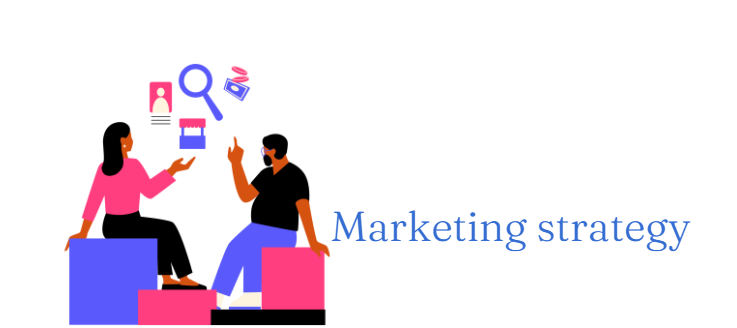
Having a solid email marketing strategy is essential for an eCommerce site or business owner.
1. Choose an email service provider (ESP)
Select a well-reviewed ESP that fits your needs, such as pricing, drag-and-drop editors, and email templates.
Popular ESPs include Shopify Email (integrated with Shopify stores), Klaviyo, Privy, and Omnisend.
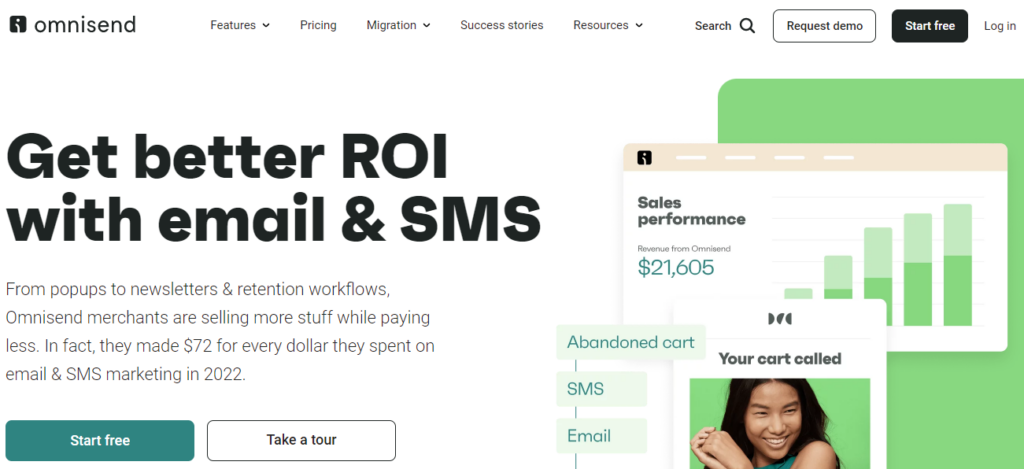
2. Start building your email list
Collecting email addresses from the start is essential. Obtain permission from subscribers to follow up with them over time. Here are some strategies to build your email list:
- Set up a pre-launch page on your domain to capture email addresses of interested visitors.
- Collect emails from sales and customer accounts. Shopify allows optional customer accounts, and you can send direct invitations to activate accounts after purchase.
- Place opt-in forms across your site in relevant locations, such as the header, navigation, footer, About Us page, blog, or resource pages. Consider using pop-up forms with exit-intent triggers.
- Accelerate sign-ups with lead magnets, such as exclusive deals, discounts, contests, or access to educational content.
- Ask for emails in person, whether through pop-up shops, physical storefronts, or packaging inserts.
3. Send emails legally
Ensure your email marketing practices comply with the relevant rules and regulations. Familiarize yourself with the following:
- CAN-SPAM Act: Sets rules for commercial emails, such as including accurate header information, providing an opt-out mechanism, and including your physical address.
- GDPR (General Data Protection Regulation): Protects personal data for individuals within the European Union. It requires explicit consent and provides individuals with the right to access and control their data.
- CASL (Canadian Anti-Spam Legislation): Applies to sending commercial electronic messages to Canadian recipients, requiring consent and proper identification.
Note: This information is for reference purposes only and does not constitute legal advice. Consult a lawyer specializing in email marketing regulations for specific inquiries.
Google Analytics and email marketing
Google Analytics is a powerful tool that greatly enhances your eCommerce email marketing effort.
By integrating Google Analytics with your email marketing platform, you can gain valuable insights into the performance and effectiveness of your campaigns.
Track key metrics like open rates, click-through rates, and conversions, and analyze customer behavior to understand engagement and browsing patterns.
Measure revenue and ROI to evaluate campaign effectiveness and allocate resources wisely. Segment and target audiences for personalized content, conduct A/B testing to optimize conversions, and analyze customer lifetime value for tailored messaging.
Finally, gain a holistic view of email attribution in relation to other channels to optimize your overall marketing mix.
Google Analytics empowers you with the data and insights needed to drive the success of your eCommerce email marketing efforts.
Conclusion
Email marketing is a powerful tool that every eCommerce store owner should incorporate into their overall marketing strategy. It is a cost-effective and efficient way to engage with customers, drive sales, and build lasting relationships.
To recap, here are the 10 strategies you should implement in your eCommerce email marketing strategy:
- Start with a welcome series.
- Be sure to include a clear call to action.
- Use personalization to segment your list.
- Automate what you can.
- Create a dynamic cart abandonment series.
- Perform split testing.
- Use email to encourage engagement.
- Offer exclusive experiences and rewards to loyal subscribers.
- Set up back-in-stock or waitlist emails.
- Utilize dynamic content.
Each strategy serves a specific purpose, from nurturing new subscribers to re-engaging with abandoned carts, testing and optimizing your emails, and delivering personalized experiences to your existing customers.
Remember, email marketing is not a one-time effort but an ongoing process.
Continuously analyze your results, make data-driven improvements, and adapt your strategies to meet the evolving needs and preferences of your target audience.
So, don’t wait any longer—get started with email marketing services today and unlock the full potential of your eCommerce business.
